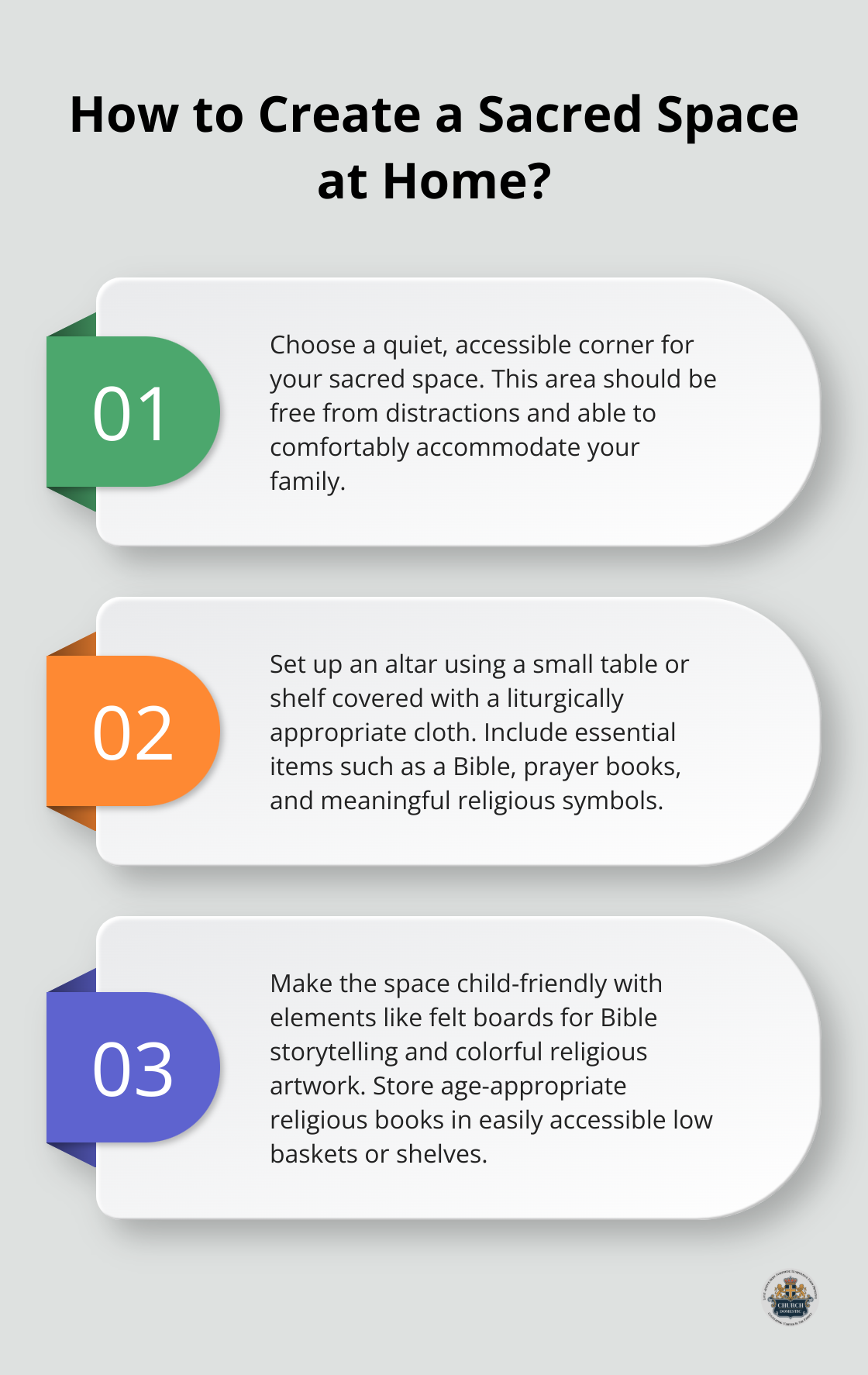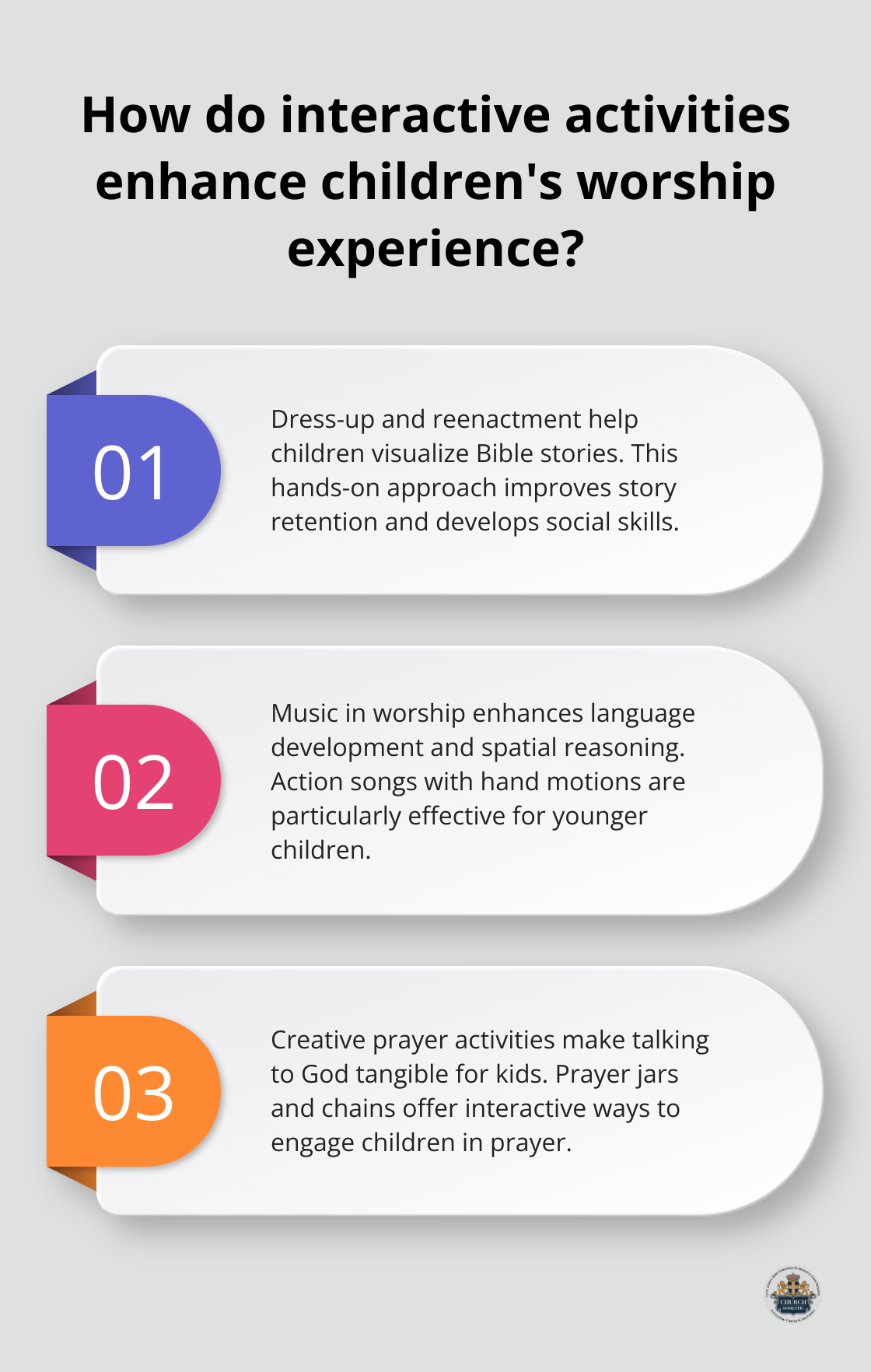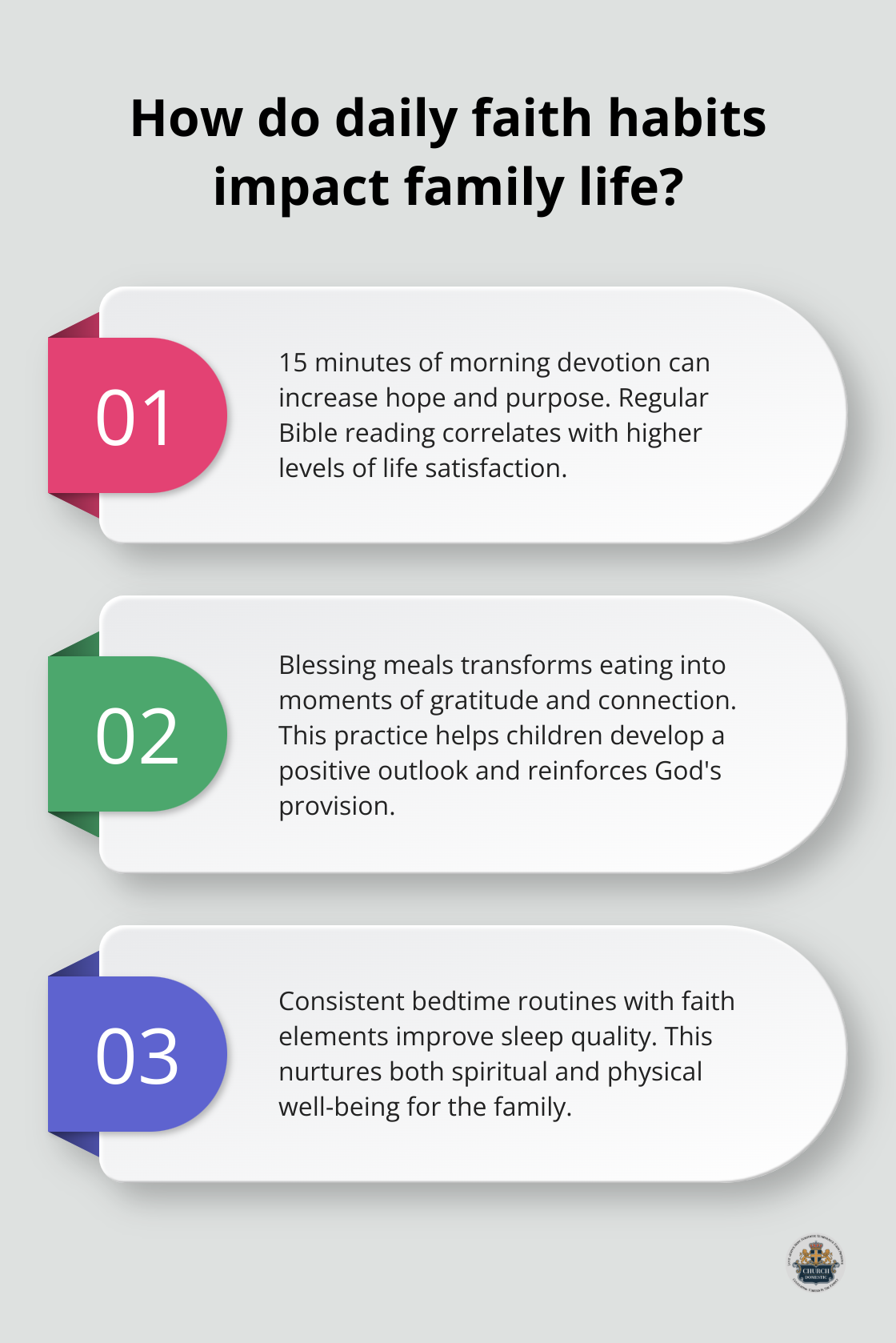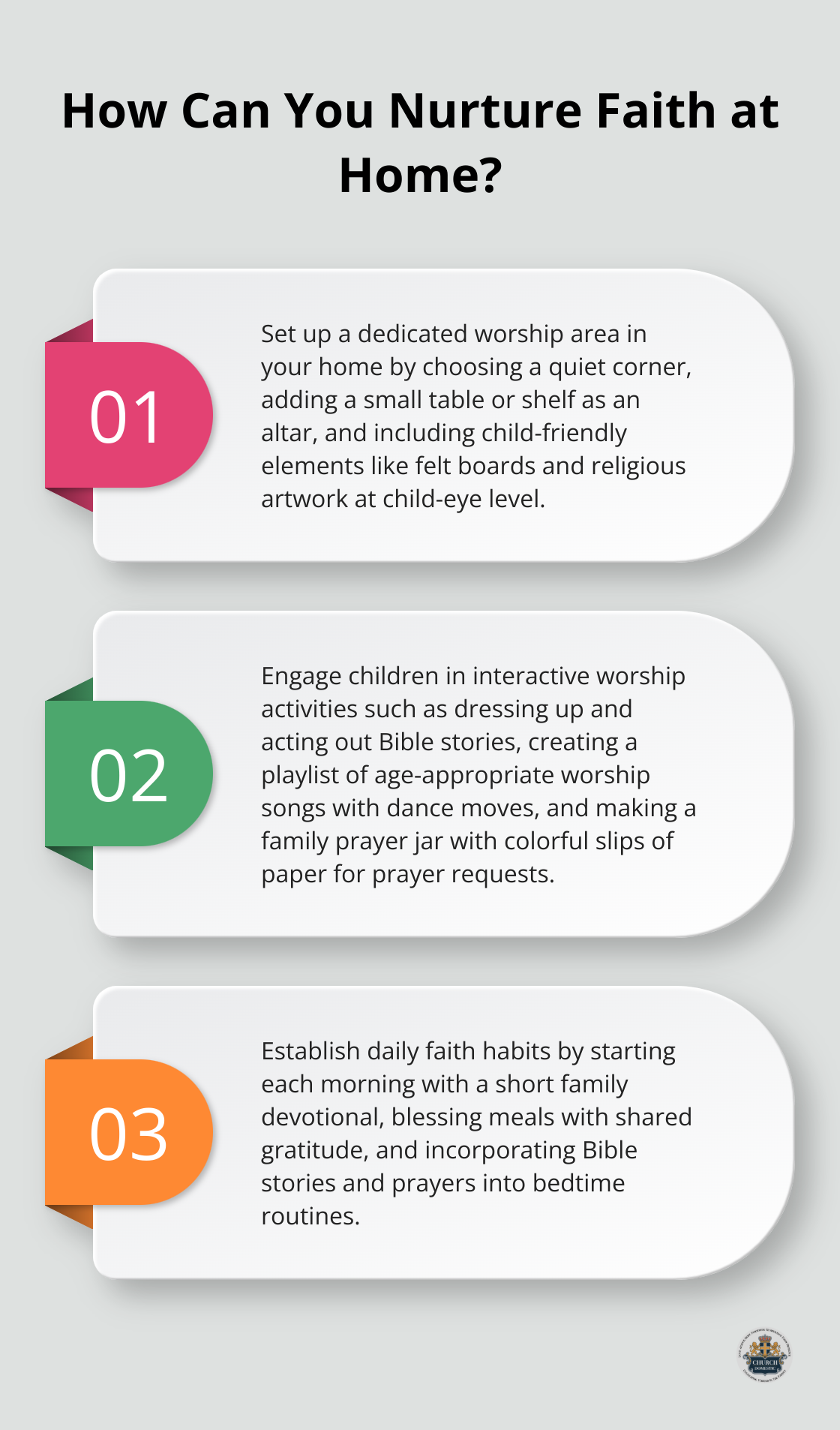At Church Domestic, we understand the challenge of keeping young children engaged during worship. Families often struggle to find meaningful ways to involve their little ones in spiritual practices.
This blog post offers practical worship activities and ideas to help you create a vibrant faith environment at home. We’ll explore how to set up child-friendly worship spaces, engage in interactive activities, and establish daily rituals that nurture your family’s spiritual growth.
How to Create a Sacred Space at Home
Creating a sacred space at home can enhance your family’s spiritual experience. This dedicated area serves as a visual and physical reminder of your commitment to faith, making it easier to incorporate worship into your daily routine.
Choose the Right Location
Select a quiet corner of your home that’s easily accessible to all family members. This could be a spare room, a nook in the living room, or even a section of a hallway. Pick a spot that’s free from distractions and can comfortably accommodate your family.
Set Up Your Worship Area
After you’ve chosen your location, set it up. Start with a small table or shelf to serve as an altar. Cover it with a cloth in colors that reflect the current liturgical season. Add a Bible, prayer books, and a cross or other religious symbols that are meaningful to your family.

For seating, use floor cushions or small chairs that you can easily move. This flexibility allows you to arrange the space differently for various activities (from quiet prayer to lively worship sessions).
Add Child-Friendly Elements
Make the space inviting for children by including elements that appeal to their senses and imagination. A felt board with Bible story characters can be a great tool for storytelling. Hang colorful religious artwork at child-eye level to spark curiosity and conversation.
Store age-appropriate religious books in a low basket or shelf where children can easily access them. Include picture Bibles, illustrated saint stories, and books about religious holidays.
Create a Sensory Experience
Engage multiple senses to create a truly immersive worship experience. Use battery-operated candles for a safe, warm glow. Play soft instrumental music or nature sounds to create a peaceful atmosphere. Consider using a small essential oil diffuser with calming scents like lavender or frankincense.
The goal is to create a space that feels special and set apart, yet comfortable and inviting for your entire family. A thoughtfully designed home worship area lays the foundation for meaningful family faith experiences.
Now that you’ve created your sacred space, let’s explore how to fill it with engaging worship activities that will captivate your young children’s hearts and minds.
Interactive Worship Activities for Young Children
At Church Domestic, we know that engaging young children in worship can transform family faith time into an exciting adventure. Let’s explore creative ways to make Bible stories come alive for your little ones.
Dress-Up and Act Out
One effective method to help children connect with Bible stories is through reenactment. Set up a simple costume box with items like bathrobes, headbands, and toy props. (These don’t need to be elaborate – a blue blanket can become the Red Sea, and a stuffed lamb can represent a flock of sheep.)

Choose a Bible story and assign roles to family members. As you read the story aloud, have everyone act out their parts. This hands-on approach helps children visualize and remember the story better. Social skills, which are part of playful learning, enable children to listen to directions, pay attention, solve disputes with words, and focus.
Sing and Dance Your Praise
Music is a powerful tool for worship, especially for children. Create a playlist of age-appropriate worship songs with simple lyrics and catchy tunes. Encourage your kids to sing along and make up dance moves to express their joy.
For younger children, incorporate action songs that involve hand motions or body movements. The National Association for Music Education states that musical activities can improve a child’s language development, spatial reasoning, and social skills.
Craft Your Prayers
Prayer doesn’t have to be a silent, seated activity. Get creative with prayer crafts that make talking to God a tangible experience for kids. Create a family prayer jar where everyone writes prayer requests on colorful slips of paper. During worship time, take turns drawing requests and praying together.
Another idea is to make a prayer chain. Cut strips of construction paper and have children write or draw their prayers on each strip. Link the strips together to form a chain, adding new links as prayers are answered or new requests arise.
Play and Learn
Incorporate Bible-themed games into your worship time to make learning fun. Create a simple board game where players move forward by answering Bible trivia questions. Or play a memory match game with cards featuring Bible characters or verses.
For puzzle enthusiasts, invest in age-appropriate Bible story puzzles. As you put the pieces together, discuss the story depicted. A study published in Developmental Psychology links puzzle play in early childhood to the development of important cognitive skills.
These interactive worship activities don’t just teach children about faith – they help them experience it firsthand. The joy and engagement these activities bring to family worship time set the stage for establishing daily rituals and routines that nurture your family’s spiritual growth. (Let’s explore how to incorporate these practices into your everyday life in the next section.)
How to Build Daily Faith Habits
Start Your Day with Devotion
Begin each morning with a short family devotional. Keep it simple and age-appropriate. For younger children, read a brief Bible story and discuss its meaning. Older kids might appreciate a daily verse to memorize or reflect on. (The American Bible Society reports that regular Bible reading correlates with higher levels of hope and purpose in life.)

Set your alarm 15 minutes earlier to ensure you have time for this practice. If mornings are hectic, try moving this to breakfast time. Consistency matters more than perfection.
Bless Your Meals
Transform mealtimes into moments of gratitude and connection. Before eating, take turns sharing one thing you’re thankful for. This practice helps children develop a positive outlook and reinforces the concept of God’s provision.
For variety, try different prayer styles. One day, use a traditional blessing. The next, have each family member contribute a line to create a unique prayer. On busy days, even a simple “Thank you, God, for this food” can keep the habit alive.
End the Day with God
Bedtime routines offer another opportunity for spiritual connection. For younger children, read a Bible story and say a short prayer together. With older kids, this can evolve into a time of reflection on the day’s events and how they relate to your faith.
(The National Sleep Foundation suggests that consistent bedtime routines improve sleep quality.) By incorporating faith elements, you nurture both spiritual and physical well-being.
Weekly Family Worship Night
Designate one evening a week for extended family worship. This could involve longer Bible readings, worship music, and more in-depth discussions about faith. Use this time to explore topics that interest your children or address questions they’ve raised during the week.
Make it special by creating a cozy atmosphere with soft lighting and comfortable seating. Consider ending with a family-friendly faith-based movie or documentary to spark further conversation.
The key to success lies in flexibility and persistence. Some days will flow smoothly, others might feel chaotic. The important thing is to keep trying. As you consistently incorporate these practices, you’ll find they become cherished family traditions that strengthen your bond and deepen your faith.
Final Thoughts
Engaging young children in worship activities requires creativity, patience, and consistency. We explored various strategies to make family faith time more interactive and meaningful. These approaches can help nurture your children’s spiritual growth, from creating a dedicated worship space at home to incorporating daily rituals.

Patience plays a crucial role in this journey. Children may not always respond as we hope, but each worship experience plants seeds that can grow over time. Trust the process and celebrate small victories along the way.
At Church Domestic, we support families in their spiritual journey. We provide resources and insights to help you navigate family life, business, and personal growth. As you implement these ideas, you’re not alone in this journey. (Keep exploring, learning, and most importantly, worship together as a family.)